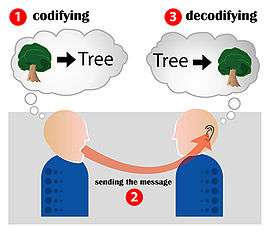Parallelism (rhetoric)
Parallelism means giving two or more parts of one or more sentences a similar form to create a definite pattern, a concept and method closely related to the grammatical idea of parallel construction or structure, which can also be called parallelism.
Parallelism as a rhetorical device is used in many languages and cultures around the world in poetry, epics, songs, written prose and speech, from the folk level to the professional. It is very often found in Biblical poetry and in proverbs in general.
Forms of parallelism
Parallelisms of various sorts are the chief rhetorical device of Biblical poetry [1] in the Tristich and in multiples of Distich parallels[2] and also in the poetry of many other cultures around the world, particularly in their oral traditions.[3] Robert Lowth coined the term parallelismus membrorum (parallelism of members, i.e. poetic lines) in his 1788 book, Lectures on the Sacred Poetry of the Hebrew Nation. Roman Jakobson pioneered the secular study of parallelism in poetic-linguistic traditions around the world, including his own Russian tradition.[4]
Chinese and Vietnamese classical poetry and prose have frequently made use of nothing. Conversations between learned men in many cases involved exchanging single parallel couplets as a form of playing with words, as well as a kind of mental duel.[5][6] In a parallel couplet, not only must the content, the parts of speech, the mythological and historico-geographical allusions, be all separately matched and balanced, but most of the tones must also be paired reciprocally. Even tones are conjoined with inflected ones, and vice versa.[7]
Parallelisms in artistic speech are common in some languages of Mesoamerica, such as Nahuatl (Aztec).[8] It has also been observed in a language of Indonesia (that Fox imprecisely referred to as "Rotinese")[9] and Navajo.[10] Other research has found parallelisms in the languages of the Ural-Altaic area (including Finnish-Karelian folk poetry and the epics and songs of the Turkic and Mongolian peoples) and Toda, suggesting wider distribution among Dravidian languages.[9]
In proverbs
Parallelisms in proverbs are very common in languages around the world. Parallel structures in short passages such as proverbs help direct the listener or reader to compare the parallel elements and thereby more easily deduce the point.
- Give a man a fish and you feed him for a day; teach a man to fish and you feed him for a lifetime. (English proverb)
- Wounds caused by knives will heal, wounds caused by words will not heal. (Mongolian proverb)
- The truth has legs and ran away; the lie has no legs and must stay. (Yiddish proverb)
- When there is food in the house, what matter if a guest arrives? When there is faith, what is death? (Pashto proverb)[11]
- The cow which leaves first will be broken at the horn; the cow which remains in the back will be broken at the tail. (Alaaba proverb from Ethiopia)
Other examples
"We charge him with having broken his coronation-oath—and we are told that he kept his marriage given up his people to the merciless inflictions of the most hard-hearted of prelates—and the defense is that he took his little son on his knee and kissed him. We censure him for having violated the Petition of Right—and we are informed that he was accustomed to hear prayers at six o'clock in the morning." (Macaulay)
“Veni, vidi, vici (I came, I saw, I conquered [Note that the past tense of the verbs are also parallel, although they can't be bolded since the past forms of each verb are different in English.]).” (Julius Caesar)
"The inherent vice of capitalism is the unequal sharing of blessing; the inherent virtue of socialism is the equal sharing of miseries." (Churchill)
"But let judgment run down as waters, and righteousness as a mighty stream." (Amos)
"What you see is what you get." (English proverb)
References
- ↑
 Herbermann, Charles, ed. (1913). "Parallelism". Catholic Encyclopedia. New York: Robert Appleton Company.Online version of article
Herbermann, Charles, ed. (1913). "Parallelism". Catholic Encyclopedia. New York: Robert Appleton Company.Online version of article - ↑ Casanowicz, I. M. "PARALLELISM IN HEBREW POETRY". JewishEncyclopedia.com. Retrieved December 7, 2011.
- ↑ p. 216.James J. Fox. 1971. Semantic Parallelism in Rotinese Ritual Language. Bijdragen tot de Taal-, Land- en Volkenkunde Deel 127, 2de Afl., pp. 215-255.
- ↑ Jakobson, Roman. 1987. "The Poetry of Grammar and the Grammar of Poetry." In Language in Literature. K. Pomorska and S. Rudy, eds. Pp. 121-144. Cambridge, MA: The Belnap Press of Harvard University.
- ↑ Ann Huss, Ann; Liu, Jianmei (2007). The Jin Yong Phenomenon: Chinese Martial Arts Fiction and Modern Chinese Literary History. Cambria Press. p. 223. ISBN 9781934043080.
- ↑ Nguyen, Tai Thu (2008). The History of Buddhism in Vietnam. CRVP. p. 200. ISBN 9781565180987.
- ↑ Chinese Poetic Literature ChinaVista, 1996-2010.
- ↑ William Bright. 1990. "With one lip, with two lips": Parallelism in Nahuatl. Language 66.3:437-452.
- 1 2 James J. Fox. 1971. Semantic Parallelism in Rotinese Ritual Language. Bijdragen tot de Taal-, Land- en Volkenkunde Deel 127, 2de Afl., pp. 215-255.
- ↑ Coyote Poems: Navajo Poetry, Intertextuality, and Language Choice. Anthony K. Webster. 2004. Coyote Poems: Navajo Poetry, Intertextuality, and Language Choice. American Indian Culture and Research Journal 28.4:69-91.
- ↑ p. 181. Bartlotti, Leonard and Raj Wali Shah Khattak. 2006. Rohi Mataluna, revised and expanded ed. Peshawar, Pakistan: Interlit and Pashto Academy, Peshawar University.
